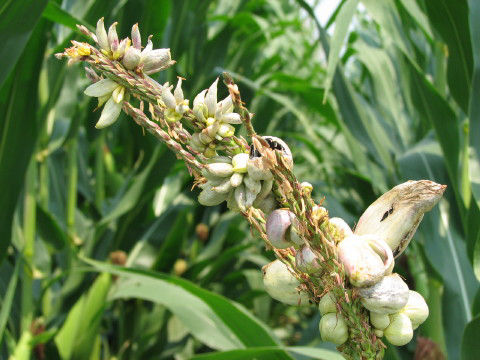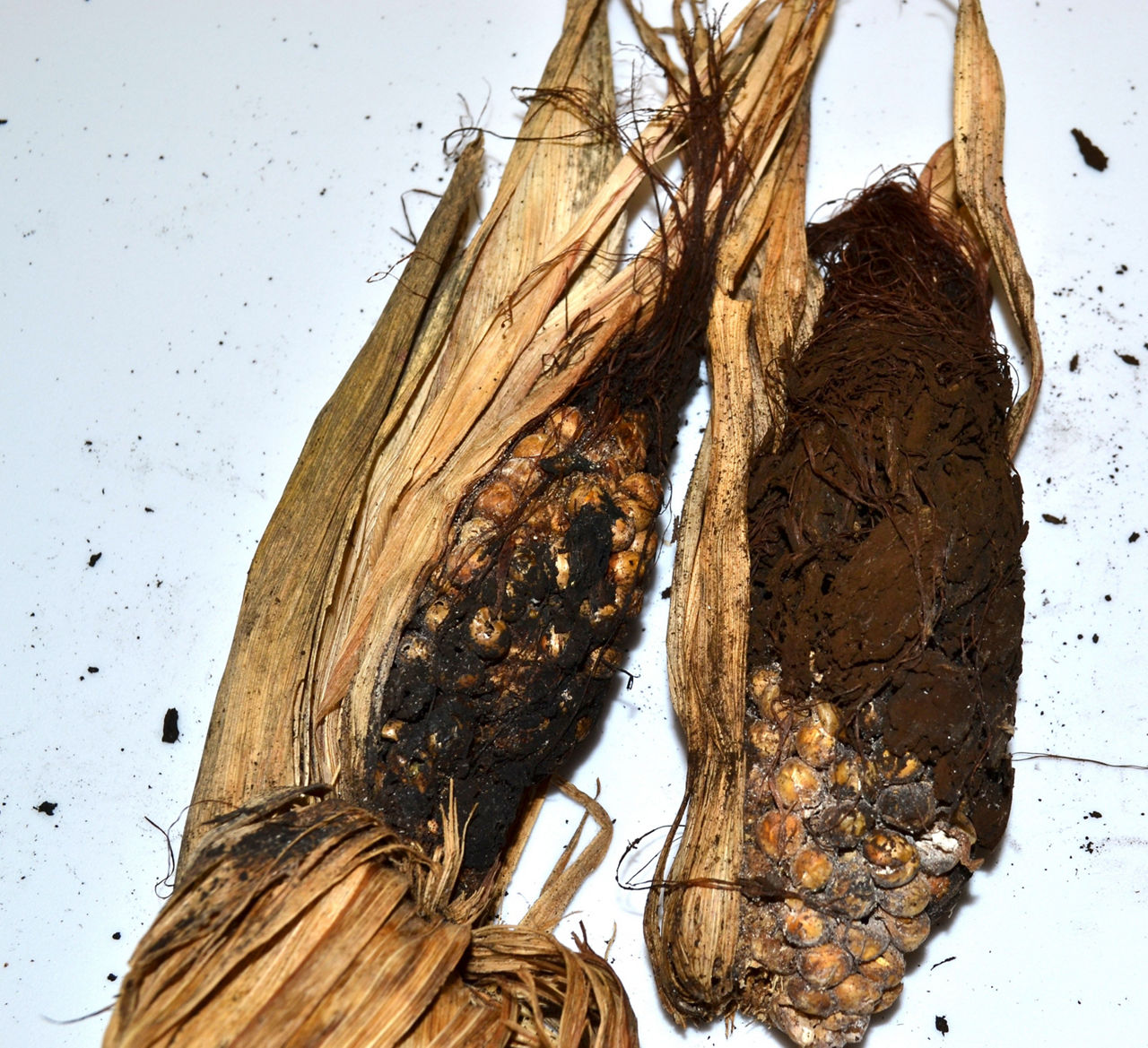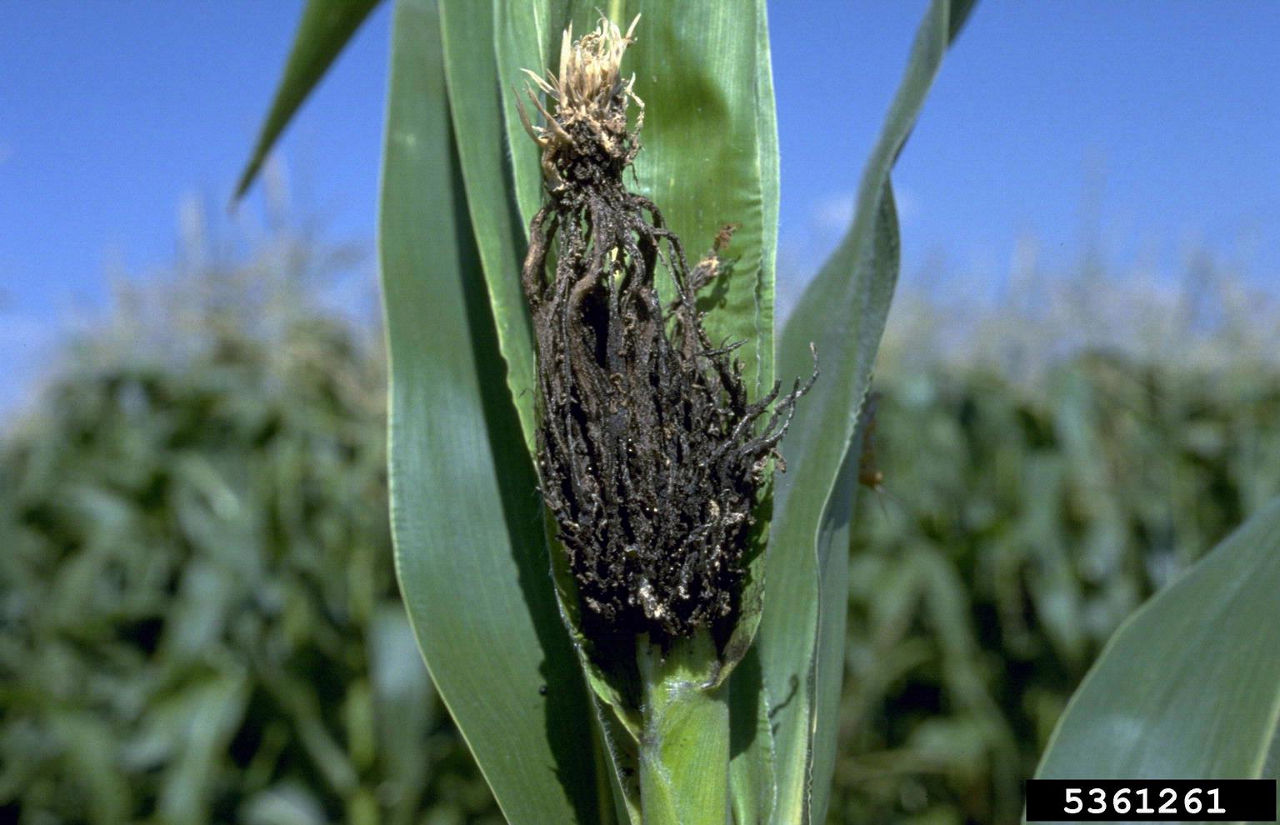5 MIN READ
Common Smut and Head Smut in Corn
November 4, 2020
Common smut is caused by the fungus Mycosarcoma maydis (also known as Ustilago maydis and Ustilago zeae) and head smut is caused by the fungus Sphacelotheca reiliana.
Common Smut
Effect on Yield
The potential for yield loss from common smut is greatest when seedlings become infected. Infected seedlings generally grow abnormally, may die, or lack ears if the plants survive and reach reproductive stages. When common smut develops on ears and kernels, any associated yield loss is likely more from unfavorable environmental conditions, such as drought or excessive moisture, rather than from the smut.
Life Cycle and Characteristics
Common smut spores overwinter in the soil, are viable for several years, and are spread by wind and rain. Smut galls can develop where wounds have occurred from insect feeding, hail, wind, and other causes. Gall development is most favorable on leaves, stalks, tassels, silks, and ears during warm, moist conditions. Drought or wet environmental conditions during or after pollination increases the potential for kernel infection.1 Non-fertilized ovules and attached silks are susceptible to infection for an extended period.2 Each point of infection is a separate event because the fungus is not systemic within the corn plant.2
Immature smut galls are firm, greenish or silvery white, and covered with a corky covering or periderm (Figures 1 and 2).2 As the galls mature, they begin to turn black. Upon maturity, the galls on ears and stalks rupture and spew powdery black teliospores (Figure 3). Galls that form on leaves usually remain small, dry out, and turn hard without rupturing.
Management
- Using strategies to help reduce the potential for common smut development is the best option for management.
- No-till planting may help reduce the potential for plant injury from blowing soil and sand.
- Caution should be exercised during cultivation and other field activities to avoid plant injury.
- Some corn products may be more tolerant to common smut and should be utilized in high pressure fields.
- A balanced fertility program should be maintained as excess nitrogen tends to increase the incidence and severity of common smut.
- Deep tillage can bury the fungus, which might reduce the inoculum level the following year.
- Fungicides do not effectively control common smut.
- Crop rotation is not a solution because the fungus is widespread and can remain viable in the soil for several years.
Head Smut
Effect on Yield
The potential for yield loss from head smut is greater than common smut because the fungus infects early vegetative corn plants and grows systemically in the plant. Yield loss occurs because the reproductive plant parts (ears and tassels) are replaced by smut sori or spore masses.3
Life Cycle and Characteristics
The primary source for head smut inoculum is the teliospores that overwinter in the soil. The spores can remain dormant for at least four years. Equipment should be cleaned when leaving infected fields because the spores can be transported to uninfected fields. A lesser transmission source can be teliospores residing on the surface of seed. Head smut is favored by low soil moisture and temperatures between 70° and 83°F, clay loam soils, and nitrogen deficient soils.4
Head smut sori are covered with a thin membrane, which easily ruptures to reveal masses of dark brown to black teliospores.3 Infected tassels are completely or partially covered by sori and normally do not produce pollen. Tassel spikelets may form a shoot like structure (Figure 4). Smutted ears may be rounded and do not produce silks (Figure 5). Thread-like strands of vascular bundles surrounded by black spores are characteristic of head smut galls. Infected plants may produce unusual leafy structures on either the ear or tassel.
Management
- Equipment should be cleaned when leaving infected fields because the spores can be transported to uninfected fields.
- Plant corn products with head smut resistance.
- Plant corn products that are characterized by quick emergence.
- Treat seed with a systemic fungicide.
- A balanced fertility program should be maintained as a lack of nitrogen tends to increase the severity of head smut.
- Crop rotation is not a solution because the spores can survive for several years in the soil.
- In-furrow fungicide treatments can be effective; however, they may not be economically feasible in areas with sporadic incidence of head smut.
Sources:
1 Munkvold, G.P. 2001. Common smut more common than usual. Integrated Crop Management News. 1875. Iowa State University Digital Repository. http://lib.dr.iastate.edu/cropnews/1875.
2 Pataky, J.K. and Snetselaar, K.M. 2006. Common smut of corn. The Plant Health Instructor. https://www.apsnet.org/edcenter/disandpath/fungalbasidio/pdlessons/Pages/CornSmut.aspx.
3 Compendium of Corn Diseases. 1999. The American Phytopathological Society.
4 Jackson-Ziems, T.A. 2014. Smut diseases of corn. NebGuide G2223. University of Nebraska. https://extensionpublications.unl.edu/assets/html/g2223/build/g2223.htm.
Additional sources:
Mohan, S.K., Hamm, P.B., Clough, G.H., and du Toit, L.J. 2013. Corn smuts. A pacific northwest extension publication, PNW647. https://catalog.extension.oregonstate.edu/.
Davis, R.M. 2006. Corn. Head smut. How to Manage Pests. UC IPM Pest Management Guidelines: Corn, UC ANR Publication 3443. Agricultural and Natural Resources, University of California. http://ipm.ucanr.edu/PMG/r113101111.html#REFERENCE.
Jackson, T. Head smut. CROPWATCH. Institute of Agriculture and Natural Resources. University of Nebraska-Lincoln. https://cropwatch.unl.edu/plantdisease/corn/head-smut.
French, R.D. and Schultz, D. 2010. Head smut of corn. PLPA-Co-010-02. AgriLIFE Extension. Texas A&M System. https://amarillo.tamu.edu/.
6005_S11











